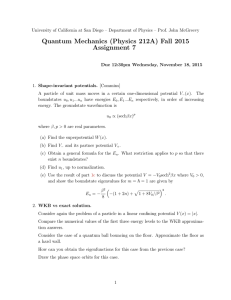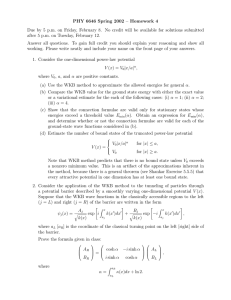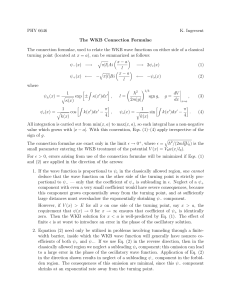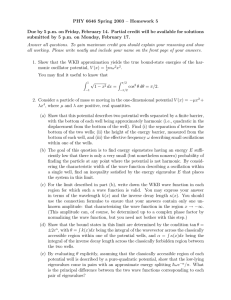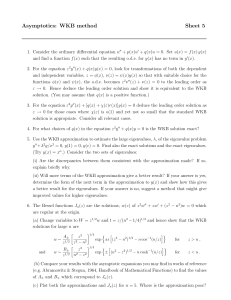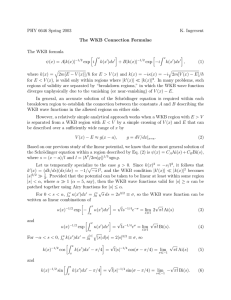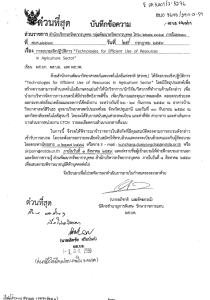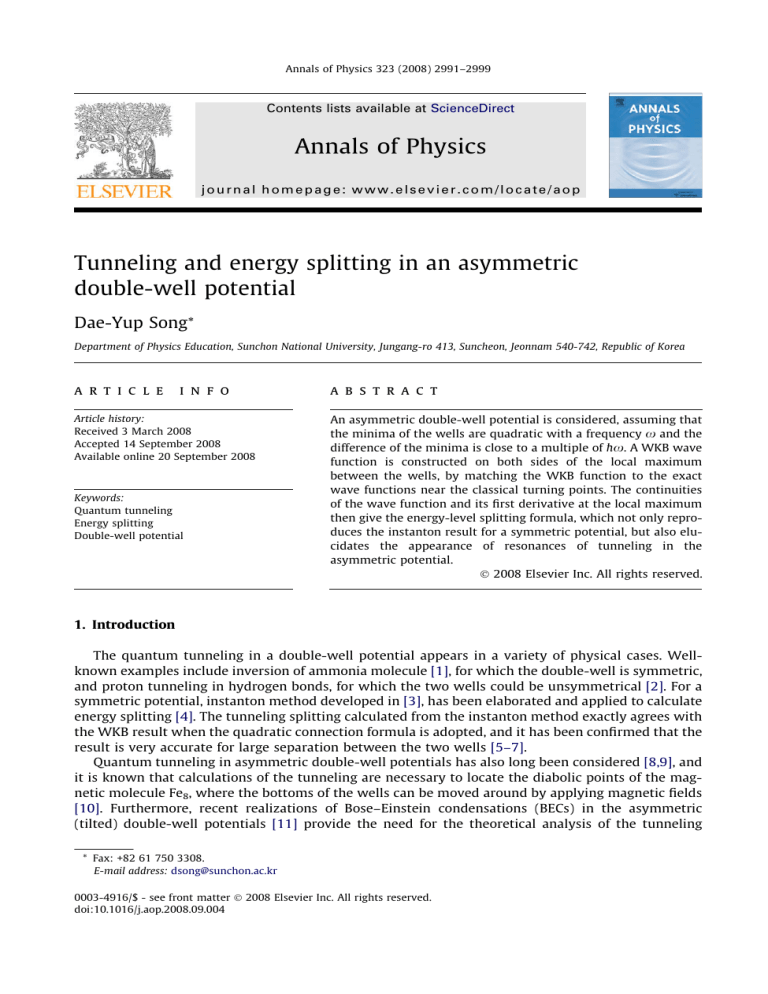
Annals of Physics 323 (2008) 2991–2999
Contents lists available at ScienceDirect
Annals of Physics
journal homepage: www.elsevier.com/locate/aop
Tunneling and energy splitting in an asymmetric
double-well potential
Dae-Yup Song*
Department of Physics Education, Sunchon National University, Jungang-ro 413, Suncheon, Jeonnam 540-742, Republic of Korea
a r t i c l e
i n f o
Article history:
Received 3 March 2008
Accepted 14 September 2008
Available online 20 September 2008
Keywords:
Quantum tunneling
Energy splitting
Double-well potential
a b s t r a c t
An asymmetric double-well potential is considered, assuming that
the minima of the wells are quadratic with a frequency x and the
difference of the minima is close to a multiple of hx. A WKB wave
function is constructed on both sides of the local maximum
between the wells, by matching the WKB function to the exact
wave functions near the classical turning points. The continuities
of the wave function and its first derivative at the local maximum
then give the energy-level splitting formula, which not only reproduces the instanton result for a symmetric potential, but also elucidates the appearance of resonances of tunneling in the
asymmetric potential.
Ó 2008 Elsevier Inc. All rights reserved.
1. Introduction
The quantum tunneling in a double-well potential appears in a variety of physical cases. Wellknown examples include inversion of ammonia molecule [1], for which the double-well is symmetric,
and proton tunneling in hydrogen bonds, for which the two wells could be unsymmetrical [2]. For a
symmetric potential, instanton method developed in [3], has been elaborated and applied to calculate
energy splitting [4]. The tunneling splitting calculated from the instanton method exactly agrees with
the WKB result when the quadratic connection formula is adopted, and it has been confirmed that the
result is very accurate for large separation between the two wells [5–7].
Quantum tunneling in asymmetric double-well potentials has also long been considered [8,9], and
it is known that calculations of the tunneling are necessary to locate the diabolic points of the magnetic molecule Fe8, where the bottoms of the wells can be moved around by applying magnetic fields
[10]. Furthermore, recent realizations of Bose–Einstein condensations (BECs) in the asymmetric
(tilted) double-well potentials [11] provide the need for the theoretical analysis of the tunneling
* Fax: +82 61 750 3308.
E-mail address: dsong@sunchon.ac.kr
0003-4916/$ - see front matter Ó 2008 Elsevier Inc. All rights reserved.
doi:10.1016/j.aop.2008.09.004
2992
D.-Y. Song / Annals of Physics 323 (2008) 2991–2999
[12]. Though interactions are important in the tunneling of the BECs realized so far [13], as the interactions between atoms are controllable, the quantum mechanics of a single particle is directly relevant
to physics of the BECs or quantum degenerate Fermi atoms in the noninteracting limit [14].
One of the intriguing properties of the tunneling in asymmetric double-well potentials is the
appearance of resonances. For example, the wave function appropriate for the false vacuum of the
potential
V D ðxÞ ¼
8
h
i
< mx2 ðx þ aÞ2 þ ðb2 a2 Þ
for x < 0
: mx2
for x P 0;
2
2
ðx bÞ
2
ð1Þ
ðb > a > 0Þ can significantly tunnel to the side of x P 0 only when b is tuned to satisfy the condition
mx2 2
ðb a2 Þ nhx;
2
n ¼ 0; 1; 2; 3 :
ð2Þ
Through various numerical calculations, it has been known that the appearance of these resonances is
not limited to V D ðxÞ, but is a general property of tunneling in asymmetric potentials [8]. In this paper,
in order to elucidate the analytic structure of the resonances, we construct the WKB wave functions
for a class of asymmetric double-well potentials.
Specifically, we consider a smooth double-well potential VðxÞ, assuming that VðxÞ has minima at
x ¼ b and at x ¼ a ða; b > 0Þ, and a local maximum at x ¼ 0. The minima are taken to be quadratic
hx (See Fig. 1). As in the instanton method, we
with a frequency x, VðbÞ ¼ 0, and VðaÞ ¼ ðn þ Þ
are interested in the large separation between the two wells, and consider the ground and low lying
excited states of energy eigenvalue E satisfying Vð0Þ E > n
hx. We also assume that the potential is
still quadratic near the classical turning points between the wells.
Around the minima, exact solutions to the Schrödinger equation are described by the parabolic cylinder functions [15]. As anticipated in [10], on both sides of x ¼ 0, a WKB wave function is constructed
by matching the WKB function to the asymptotic forms of the exact solutions near the classical turning points. The continuities of the wave function and its first derivative at the local maximum then
give the energy-level splitting formula. Though our method of requiring continuities is very different
from the instanton or WKB method in [4], the splitting formula reduces to the known one in the symmetric case [4,16,17].
In the symmetric potential, for a given energy, an approximate solution to the Schrödinger equation localized in left(right) well implies, by the inversion symmetry, another solution localized in
the right(left) well, and this fact has been conveniently used to evaluate energy splittings [18,16].
In this paper, we also show that tunneling in the asymmetric potential of ¼ 0 can be explored by
V (x )
−a
b
Fig. 1. An asymmetric double-well potential VðxÞ: VðbÞ ¼ 0, VðaÞ ¼ ðn þ Þ
hx, ðn ¼ 0; 1; 2; Þ. We assume that, for a given
energy E, VðxÞ is quadratic in the regions of classical motions with the frequency x, and concentrate on the case of 1.
D.-Y. Song / Annals of Physics 323 (2008) 2991–2999
2993
assuming the degenerate approximate solutions to the Schrödinger equation wR ðxÞ and wL ðxÞ which are
localized in the right and left wells, respectively. By explicitly constructing wR ðxÞ and wL ðxÞ, the splitting formula is found from these wave functions. Indeed it turns out that the WKB wave functions satisfying the continuities could be written as linear combinations of wR ðxÞ and wL ðxÞ, while the linear
combinations lift the degeneracy to make the splitting. Therefore, a linear combination of the timedependent WKB wave functions gives a system which shuttles back and forth between wR ðxÞ and
wL ðxÞ, to clearly elucidate the resonance structure of the tunneling in the asymmetric potential of
¼ 0.
This paper is organized as follows: in Section 2, we construct the WKB wave function on both
sides of the local maximum and, by requiring the continuities at the maximum, we evaluate the energy splitting. In Section 3, we find the appropriate localized wave functions wR ðxÞ and wL ðxÞ, to reobtain the energy splitting formula. We also establish a time-dependent WKB wave function of a
system shuttling back and forth. In Section 4, we give some concluding remarks. Finally in Appendix
A we give exact solutions for the system of V D ðxÞ in the limit of large separation between the two
wells.
2. WKB method with continuity requirements
As the results could be easily modified to incorporate the small non-zero , we start with
¼ 0.
2.1. WKB wave function for x P 0
For the wave function wI ðxÞ of the energy eigenvalue E ¼
the Schrödinger equation is written as
2
2
d
h
mx2
wI þ
ðx bÞ2 wI ¼ hx
2
2m dx
2
mþnþ
m þ n þ 12 hx around the right minimum,
1
w:
2 I
ð3Þ
By introducing
lho
rffiffiffiffiffiffiffiffiffi
h
;
¼
mx
ð4Þ
pffiffiffi
and zR ¼ 2ðx bÞ=lho , we rewrite the equation as
2
d wI
þ
dz2R
1
2
mþnþ z2R
wI ¼ 0;
4
to obtain
wI ðxÞ ¼ C R Dmþn ðzR Þ ¼ C R Dmþn
!
pffiffiffi
2ðx bÞ
;
lho
ð5Þ
where C R is a constant and Dmþn denotes the parabolic cylinder function [15]. Bearing in mind that we
R1
wish to construct a normalizable wave function, we choose the solution in Eq. (5) so that b jwI ðxÞj2 dx
is finite if the expression of wI ðxÞ is valid for x > b. Asymptotic expansions of the parabolic cylinder
function are well-known. For large and negative z (z 1 and z j k j), we have
pffiffiffiffiffiffiffi
kðk 1Þ
ðk þ 1Þðk þ 2Þ
2p kpi z2 k1
z2
4 z
Dk ðzÞ e 4 zk 1 þ
e
1
þ
þ
:
e
2z2
2z2
CðkÞ
ð6Þ
For x > 0, a classical turning point may be written as
x ¼ bm ¼ b pffiffiffiffiffiffiffiffiffiffiffiffiffiffiffiffiffiffiffiffiffiffiffiffiffiffi
2m þ 2n þ 1lho :
ð7Þ
In the classically forbidden region of bm x lho , within the WKB approximation, a solution wII ðxÞ to
the Schrödinger equation is given as a linear combination of exponentially growing and decaying
functions:
2994
D.-Y. Song / Annals of Physics 323 (2008) 2991–2999
R x pðyÞ
R x pðyÞ
AR
BR
dy
dy
wII ðxÞ ¼ pffiffiffiffiffiffiffiffiffi e 0 h þ pffiffiffiffiffiffiffiffiffi e 0 h ;
pðxÞ
pðxÞ
ð8Þ
where pðxÞ is defined as
pðxÞ ¼
pffiffiffiffiffiffiffiffiffiffiffiffiffiffiffiffiffiffiffiffiffiffiffiffiffiffiffiffi
2m½VðxÞ E;
ð9Þ
and AR ; BR are constants. In the region of quadratic potential satisfying b x b bm , by introducing
UR ðxÞ ¼ Z
bm
x
pðyÞ
dy ¼ h
Z
bm
h
ðb yÞ2 ðb bm Þ2
x
2
lho
i1=2
dy;
ð10Þ
we have [19,16]
UR ðxÞ ¼ ðb xÞ2
2
2lho
2 !
1
1
2ðb xÞ
b bv
;
þO
þ ð2m þ 2n þ 1Þ þ ð2m þ 2n þ 1Þ ln
4
2
b bm
bx
ð11Þ
and thus
"Z
#
pffiffiffi
mþnþ12
bm
AR
2 eðb xÞ
pðyÞ
ðb xÞ2
wII ðxÞ pffiffiffiffiffiffiffiffiffiffiffiffiffiffiffiffiffiffiffiffiffiffiffi
exp
dy 2
b bm
h
mxðb xÞ
0
2lho
" Z
#
mþnþ12
bm
BR
b bm
pðyÞ
ðb xÞ2
:
exp dy þ
þ pffiffiffiffiffiffiffiffiffiffiffiffiffiffiffiffiffiffiffiffiffiffiffi pffiffiffi
2
h
mxðb xÞ 2 eðb xÞ
0
2lho
ð12Þ
As we are interested in the limit of large separation between the two wells where the energy splitting
is small, we introduce dl with an integer l ð¼ ½mÞ as
dl ¼ m l;
ð13Þ
so that
jdl j 1:
ð14Þ
In the region of the quadratic potential the wave function is also described by wI ðxÞ. Making use of the
asymptotic form in (6), for b x lho , in the leading orders we obtain
2
6
wI ðxÞ C R 4e
ðxbÞ2
2l2
ho
3
!lþn
pffiffiffi
pffiffiffiffiffiffiffi
ðxbÞ2
p
2ðx bÞ
2
ðl
þ
nÞ!
2
7
þ dl e 2lho pffiffiffi
5:
lþnþ1
lho
1
2lho ðx bÞ
ð15Þ
By matching the asymptotic form of wI ðxÞ onto that of wII ðxÞ in this overlap region, we have
sffiffiffiffiffiffiffiffiffiffiffiffiffiffiffiffiffiffiffiffiffiffiffiffiffiffi
R
hðl þ nÞ!g lþn bl pðyÞ
dy
pffiffiffiffi
e 0 h ;
AR ¼ ð1Þ C R
2 plho
sffiffiffiffiffiffiffiffiffiffiffiffiffiffiffiffiffiffiffiffiffiffiffiffiffiffiffiffiffiffi
R
2p3=2 hðl þ nÞ! bl pðyÞ
dy
lþnþ1
e 0 h ;
C R dl
BR ¼ ð1Þ
lho g lþn
lþn
ð16Þ
ð17Þ
where
gk ¼
pffiffiffiffiffiffiffi kþ12
1
2p
eðkþ1=2Þ :
kþ
2
k!
ð18Þ
2.2. WKB wave function for x 6 0
hx near the minimum of the left well, a classical turning point is
Since VðxÞ ¼ mx2 ðx þ aÞ2 =2 þ n
given as
2995
D.-Y. Song / Annals of Physics 323 (2008) 2991–2999
x ¼ am ¼ a þ
pffiffiffiffiffiffiffiffiffiffiffiffiffiffi
2m þ 1lho :
ð19Þ
In the classically forbidden region of am þ x lho , a WKB solution may be written as
AL
wIII ðxÞ ¼ pffiffiffiffiffiffiffiffiffi e
pðxÞ
R 0 pðyÞ
h
x
dy
BL
þ pffiffiffiffiffiffiffiffiffi e
pðxÞ
R 0 pðyÞ
x
h
dy
ð20Þ
;
where AL ; BL are constants. In the region of the quadratic potential satisfying a þ x a av , from the
fact that
UL ðxÞ ¼ Z
x
am
pðyÞ
dy ¼ h
Z
x
h
ða þ yÞ2 ða am Þ2
am
2
lho
i1=2
dy;
ð21Þ
we obtain
" Z
#
lþ12
0
AL
a am
pðyÞ
ða þ xÞ2
wIII ðxÞ pffiffiffiffiffiffiffiffiffiffiffiffiffiffiffiffiffiffiffiffiffiffiffi pffiffiffi
exp dy þ
2
h
mxða þ xÞ 2 eða þ xÞ
am
2lho
"
#
pffiffiffi
lþ1
Z 0
BL
2 eða þ xÞ 2
pðyÞ
ða þ xÞ2
þ pffiffiffiffiffiffiffiffiffiffiffiffiffiffiffiffiffiffiffiffiffiffiffi
:
exp
dy 2
a am
h
mxða þ xÞ
am
2lho
With zL ¼
2
ð22Þ
pffiffiffi
2ðx þ aÞ=lho , the Schrödinger equation around the left minimum is written as
d wIV
þ
dz2L
1
2
mþ z2L
wIV ¼ 0;
4
and thus
wIV ðxÞ ¼ C L Dm ðzL Þ ¼ C L Dm !
pffiffiffi
2ðx þ aÞ
;
lho
ð23Þ
R a
with a constant C L . The solution in (23) is chosen, so that 1 jwIV ðxÞj2 dx is finite if the expression of
wIV ðxÞ is valid for x < a. Around the left minimum of a þ x lho , from (14) and the asymptotic form in
(6), in the leading orders we have
2
6
wIV ðxÞ ð1Þl C L 4e
ðxþaÞ2
2l2
ho
!l
pffiffiffi
pffiffiffiffiffiffiffi
ðxþaÞ2
2ðx þ aÞ
2pl!
2
dl e 2lho pffiffiffi
lho
1
2lho ðx þ aÞ
3
lþ1
7
5:
ð24Þ
By matching wIII ðxÞ to wIV ðxÞ in the overlap region, we obtain
sffiffiffiffiffiffiffiffiffiffiffiffiffiffiffiffiffi R
0
dy
2p3=2 hl! a pðyÞ
e l h ;
AL ¼ ð1Þ C L dl
lho g l
sffiffiffiffiffiffiffiffiffiffiffiffiffiffiffiffi R
0 pðyÞ
dy
hl!g pffiffiffiffi l e al h :
BL ¼ ð1Þl C L
2 plho
lþ1
ð25Þ
ð26Þ
2.3. Continuity and energy splitting
For a smooth potential, a wave function and its first derivative must be continuous at x ¼ 0, which
gives the relations
AL ¼ A R ;
BL ¼ BR :
ð27Þ
There are three unknowns C L ; C R ; dl in these two equations, while another equation may come from
the normalization of the wave function. From AL =BL ¼ AR =BR , making use of Eqs. (16), (17), (25), and
(26), we obtain
2996
D.-Y. Song / Annals of Physics 323 (2008) 2991–2999
d2l
"
g l g lþn
¼
exp 2
ð2pÞ2
Z
bl
al
#
pðyÞ
dy ;
h
ð28Þ
which indicates that the splitting of the energy level Dl is given by
" Z
pffiffiffiffiffiffiffiffiffiffiffiffi hx
Dl ¼ g l g lþn
exp p
bl
al
#
pðyÞ
dy :
h
ð29Þ
For a symmetric potential of n ¼ 0, (29) exactly agrees with the result in [16,17].
Expression in (29) is not easy to use, because the integrand in the exponential is close to a singularity near the limits. By introducing
Ia ¼
Z
Z
qffiffiffiffiffiffiffiffiffiffiffiffiffiffiffiffiffiffiffiffiffiffiffiffiffiffiffiffiffiffiffiffiffiffiffi
2m½VðyÞ nhx dy; Ib ¼
0
b
pffiffiffiffiffiffiffiffiffiffiffiffiffiffiffiffiffi
2mVðyÞ dy;
ð30Þ
0
a
and
ca ¼
cb ¼
Z
!
pffiffiffiffiffiffiffiffiffiffiffi
mx2
1
pffiffiffiffiffiffiffiffiffiffiffiffiffiffiffiffiffiffiffiffiffiffiffiffiffiffiffiffiffiffiffiffiffiffiffiffiffiffiffi dy;
2½Vðy aÞ nhx y
!
pffiffiffiffiffiffiffiffiffiffiffi
mx2
1
pffiffiffiffiffiffiffiffiffiffiffiffiffiffiffiffiffiffiffiffiffi dy;
2Vðb yÞ y
a
0
Z
b
0
ð31Þ
the splitting is written for a general potential as
!lþ1=2 pffiffiffi
!lþnþ1=2
pffiffiffi
pffiffiffi
2eðIa þIb Þ=h
2aeca
2becb
ffiffiffiffiffiffiffiffiffiffiffiffiffiffiffiffiffiffiffiffiffi
p
Dl ¼ hx
:
lho
lho
pðl þ nÞ!l!
ð32Þ
The expression in (32) can be conveniently used to find that our formula reduces to the known one
in [17] for a symmetric potential.
2.4. For a non-zero
The above formalism can be modified to include non-zero , as far as dl 1. In this case, without a
change in wI ðxÞ and wII ðxÞ, the modifications of wIII ðxÞ and wIV ðxÞ are obtained by replacing dl with dl (or,
m with m ). Due to the changes in Eqs. (24,25), the continuity requirements then give the relation
dl ðdl Þ ¼
Dl 2
:
2hx
ð33Þ
If Dl denotes the energy splitting in the presence of , (33) implies
Dl ¼
qffiffiffiffiffiffiffiffiffiffiffiffiffiffiffiffiffiffiffiffiffiffiffiffiffiffiffi
2
D2l þ ðhxÞ :
ð34Þ
3. An alternative method with localized wave functions
For ¼ 0, if we assume two states of the normalized real wave functions wR ðxÞ and wL ðxÞ with energy E0 as mentioned in Section 1, the Hamiltonian in this two-state subspace may be given by
H¼
E0
D=2
D=2 E0
with the Pauli matrices
D¼2
Z
D
rx ;
2
ð35Þ
ri ði ¼ 1; 2; 3Þ, where the small tunneling splitting D is written as
1
wL ðxÞ 1
¼ E0 I þ
!
2
2
d
h
þ
VðxÞ
wR ðxÞ dx :
2m dx2
ð36Þ
D.-Y. Song / Annals of Physics 323 (2008) 2991–2999
The two eigenstates of the Hamiltonian are given by ðwR ðxÞ
equations for these eigenstates, and the equations
2997
pffiffiffi
wL ðxÞÞ= 2. From the Schrödinger
"
#
2
2
d
h
þ VðxÞ wi ðxÞ ¼ E0 wi ðxÞði ¼ R; LÞ;
2m dx2
and from the requirements
Z
1
ðwR ðxÞÞ2 dx 1;
Z
0
0
ðwL ðxÞÞ2 dx 1;
Z
1
wL ðxÞwR ðxÞ dx 0;
ð37Þ
0
1
we find
2
D
h
w ð0Þw0R ð0Þ wR ð0Þw0L ð0Þ ;
m L
ð38Þ
with w0i ðxÞ ¼ dwi ðxÞ=dx ði ¼ R; LÞ, which is a generalization of the method used for the symmetric case
[16,18].
In the classically forbidden region, we may write
NR
wR ðxÞ ¼ pffiffiffiffiffiffiffiffiffi e
pðxÞ
R x pðyÞ
0
h
dy
;
NL
wL ðxÞ ¼ pffiffiffiffiffiffiffiffiffi e
pðxÞ
R x pðyÞ
0
h
dy
ð39Þ
;
where N R and N L are constants. From these expressions of wR ðxÞ and wL ðxÞ, by assuming that the validity condition for the WKB approximation
d h
1
dx p
ð40Þ
is satisfied at x ¼ 0, we obtain
D2
h
jN L NR j:
m
ð41Þ
For E0 ¼ ðl þ n þ 12Þ
hx, near the right-hand well, wR ðxÞ would be accurately described by the ðl þ nÞth
harmonic oscillator eigenfunction. This description holds well into the forbidden region, and, for
ðb xÞ=lho 1, we may write
2
!lþn
pffiffiffi
exp ðxbÞ
2
2lho
2ðx bÞ
ffiffiffiffiffiffiffiffiffiffiffiffiffiffiffiffiffiffiffiffiffiffiffiffiffiffiffi
ffi
wR ðxÞ qp
:
ffiffiffiffi
lho
plho ðl þ nÞ!
ð42Þ
On the other hand, making use of (11), we can find the asymptotic expansion form of wR ðxÞ of (39) in
the overlap region. By matching the asymptotic form onto the expression in (42), we obtain
" Z
#
pffiffiffiffiffiffiffiffiffiffiffi
bm
hg
pðyÞ
NR ¼ ð1Þlþn pffiffiffiffiffiffiffilþn exp dy :
h
2plho
0
ð43Þ
Similarly, by matching the asymptotic form of wL ðxÞ onto that of the lth excited harmonic oscillator
state near the left-hand well, we have
pffiffiffiffiffiffiffi
Z 0
hg
pðyÞ
NL ¼ pffiffiffiffiffiffiffi l exp dy :
h
2plho
am
ð44Þ
By plugging these explicit forms of N R and N L into (41), for E0 ¼ ðl þ n þ 12Þ
hx, we confirm that D reduces to Dl .
If (27) is satisfied, after some algebra, we find that wII ðxÞ and wIII ðxÞ of ¼ 0 can be merged, in the
classically forbidden region, into
"Z
#
pffiffiffiffiffiffiffi
h
bm
pðyÞ
2pAR lho
wWKB ðxÞ ¼ pffiffiffiffiffiffiffiffiffiffiffi exp
dy ð1Þlþn wR ðxÞ
h
hg lþn
0
i
wL ðxÞ ;
ð45Þ
2998
D.-Y. Song / Annals of Physics 323 (2008) 2991–2999
namely, wWKB ðxÞ becomes wII ðxÞ for x P 0, and wIII ðxÞ for x 6 0, where wþ
WKB ðxÞ ðwWKB ðxÞÞ is given when
we choose dl > 0 ðdl < 0Þ in (28). Thus this alternative method is in fact equivalent to the WKB method
of requiring the continuities. We also note that wþ
WKB ðxÞ has a node in the classically forbidden region
ðxÞ
has
no
node
in
the same region.
between the wells, while w
WKB
A (unnormalized) time-dependent WKB solution is given as
wðx; tÞ ¼ eixðnþlþ2þjdl jÞt wþWKB ðxÞ þ eixðnþlþ2jdl jÞt wWKB ðxÞ
"
#
pffiffiffiffiffiffiffi
Z bm
1
pðyÞ
2pAR lho
¼ 2 pffiffiffiffiffiffiffiffiffiffiffi exp ix n þ l þ
tþ
dy
2
h
h
g lþn
0
Dl
Dl
ð1Þlþn cos
t wR ðxÞ i sin
t wL ðxÞ :
2h
2h
1
1
ð46Þ
This last form shows clearly that the system shuttles back and forth between wR ðxÞ and wL ðxÞ with the
h.
frequency Dl =
In order to include , let us consider a slight modification of the potential around the left well so
hx. While wR ðxÞ would still be an appropriate solution of
that VðaÞ changes from n
hx to ðn þ Þ
the new system with energy E0 , we introduce wL ðxÞ as an approximate solution with energy
hx localized in the left well. If we confine our attention on the two state subspace described
E0 þ by wR ðxÞ and wL ðxÞ, within the approximation that wL ðxÞ is the same with wL ðxÞ, the Hamiltonian of
the new system is written as
1
1
E0 þ hx I þ ðhxrz þ Dl rx Þ;
2
2
which is analogous to that of a particle in a magnetic field [20]. This spin analogy can be used to derive
(34) and to easily find the time-evolution of the system. If w ðx; tÞ is a solution in this subspace with
R1
w ðx; 0Þ ¼ wR ðxÞ, the maximum of the probability of j 1 ðwL ðxÞÞ w ðx; tÞ dxj2 during the time-evolution
xÞ2 , which indicates that the resonance peaks in tunneling have
can be evaluated to be D2l =½D2l þ ðh
the Lorentzian shape.
4. Concluding remarks
Energy splitting formula has been obtained for the asymmetric double-well potential, by assuming
that the potential is quadratic near the minima. As has been well known for the symmetric case, we
expect that the splitting formula given here would be very accurate for the large separation between
wells, which needs to be confirmed through numerical calculations. If we could add a linear term sx to
the potential VðxÞ of ¼ 0 with a controllable constant s, VðxÞ þ sx has two minima at x ¼ b s=mx2
and at x ¼ a s=mx2 . Since the difference of the minima is given as n
hx sða þ bÞ, in the light of
numerical results [8], the tunneling would be significant only if s is close to a multiple of
h
x=ða þ bÞ. It would be of great interest to realize the asymmetric system with controllable constants,
as is partially accomplished in dynamical situations [11]. For n ¼ 0 and ¼ 0, we note that
2
D2l =D0 ¼ ð2abeca þcb =lho Þ2l =ð2lÞ! which shows the quasi-Weierstrassian nature of the tunneling spectrum [17]. In this asymmetric case, thus, the tunneling behavior of an initially squeezed wave packet
is erratic, and the trajectory of the expected position of the wave packet has a fractal structure. As a
final remark, though the results obtained in this paper would be exact in the limit of a; b lho where
an energy splitting is very small, numerical calculations imply that the appearance of resonances is
manifest even when a and b are only a few times larger than lho [8], which could be important in
the quantum tunnelings of the BECs.
Acknowledgments
I am thankful to Lincoln D. Carr for helpful comments. I am also thankful to the referee for his helpful criticism.
D.-Y. Song / Annals of Physics 323 (2008) 2991–2999
2999
Appendix A. For the potential V D ðxÞ in (1), WKB method may not be applicable, since the potential is
not differentiable at x ¼ 0. In this case, however, exact wave functions could be written in terms of the
parabolic cylinder functions on both sides of x ¼ 0. From the continuities of the wave function and its
2
hx; we find that the eigenstate of an energy
first derivative at x ¼ 0, assuming m2x ðb2 a2 Þ ¼ ðn þ Þ
1
hx exists if the condition
eigenvalue ðm þ n þ þ 2Þ
Dm pffiffiffi !
pffiffiffi !
pffiffiffi !
pffiffiffi !
2a 0
2b
2a
2b
Dmþnþ ¼ D0m Dmþnþ lho
lho
lho
lho
ð47Þ
is satisfied. (47) can be solved in the limit of a; b lho and 1. Making use of the asymptotic expansion of (6), in this limit we obtain
d2l þ ðr ðRl Ll Þ þ Þdl Rl Ll rLl ¼ 0;
ð48Þ
where
pffiffiffi
ð 2b=lho Þ2ðnþlÞþ1 b2 =l2
ho ;
pffiffiffiffiffiffiffi
e
2pðl þ nÞ!
ba
r¼
:
aþb
Rl ¼
Ll ¼
pffiffiffi
ð 2a=lho Þ2lþ1 a2 =l2
ho ;
pffiffiffiffiffiffiffi
e
2pl!
ð49Þ
(48) implies that the energy splitting is given as
qffiffiffiffiffiffiffiffiffiffiffiffiffiffiffiffiffiffiffiffiffiffiffiffiffiffiffiffiffiffiffiffiffiffiffiffiffiffiffiffiffiffiffiffiffiffiffiffiffiffiffiffiffiffiffiffiffiffiffiffiffiffiffiffiffiffiffiffiffiffiffiffiffiffiffiffiffiffiffiffi
hx 4Rl Ll þ 2 þ 2r ðRl þ Ll Þ þ r2 ðRl Ll Þ2 :
ð50Þ
If we formally use the formulas in Eqs. (30,31) by replacing VðxÞ with V D ðxÞ, Dl coincides with the splitting of (50) in the symmetric case ðn ¼ 0; ¼ 0Þ.
References
[1] E. Merzbacher, Quantum Mechanics, John Wiley and Sons, New York, 1970.
[2] W.H. Miller, J. Phys. Chem. 83 (1979) 960;
R.L. Redington, J. Phys. Chem. 113 (2000) 2319.
[3] J.S. Langer, Ann. Phys. 41 (1967) 108.
[4] S. Coleman, Aspects of Symmetry, Cambridge University Press, London, 1988.
[5] K. Banerjee, S.P. Bhatnagar, Phys. Rev. D 18 (1978) 4767.
[6] F. Zhou, Z. Cao, Q. Shen, Phys. Rev. A 67 (2003) 062112.
[7] D.K. Russell, Phys. Rev. A 71 (2005) 042502.
[8] M.M. Nieto, V.P. Gutschick, C.M. Bender, F. Cooper, D. Strottman, Phys. Lett. B 163 (1985) 336.
[9] A. Ranfagni, I. Cacciari, M.A. Vitali, G. Viliani, P. Moretti, R. Ruggeri, Phys. Rev. A 74 (2006) 014102;
D. Mugnai, A. Ranfagni, M. Montagna, O. Pilla, G. Viliani, M. Cetica, Phys. Rev. A 38 (1988) 2182.
[10] A. Garg, Phys. Rev. B 64 (2001) 094414.
[11] B.V. Hall, S. Whitlock, R. Anderson, P. Hannaford, A.I. Sidorov, Phys. Rev. Lett. 98 (2007) 030402;
T. Schumm, S. Hofferberth, L.M. Andersson, S. Wildermuth, S. Groth, I. Bar-Joseph, J. Schmiedmayer, P. Krüger, Nat. Phys. 1
(2005) 57.
[12] D.R. Dounas-Frazer, A.M. Hermundstad, L.D. Carr, Phys. Rev. Lett. 99 (2007) 200402.
[13] L. Pitaevskii, S. Stringari, Phys. Rev. Lett. 87 (2001) 180402.
[14] C.A. Regal, M. Greiner, S. Giorgini, M. Holland, D.S. Jin, Phys. Rev. Lett. 95 (2005) 250404;
E.J. Mueller, Phys. Rev. Lett. 93 (2004) 190404;
D.-Y. Song, Phys. Rev. A 74 (2006) 051602(R).
[15] E.T. Whittaker, G.N. Watson, A Course of Modern Analysis, Cambridge University Press, London, 1927.
[16] A. Garg, Am. J. Phys. 68 (2000) 430.
[17] H. Dekker, Phys. Rev. A 35 (1987) 1825.
[18] L.D. Landau, E.M. Lifshitz, Quantum Mechanics, Elsevier, Amsterdam, 1977.
[19] W.H. Furry, Phys. Rev. 71 (1947) 360.
[20] A.J. Leggett, S. Chakravarty, A.T. Dorsey, M.P.A. Fisher, A. Garg, W. Zwerger, Rev. Mod. Phys. 59 (1987) 1.

